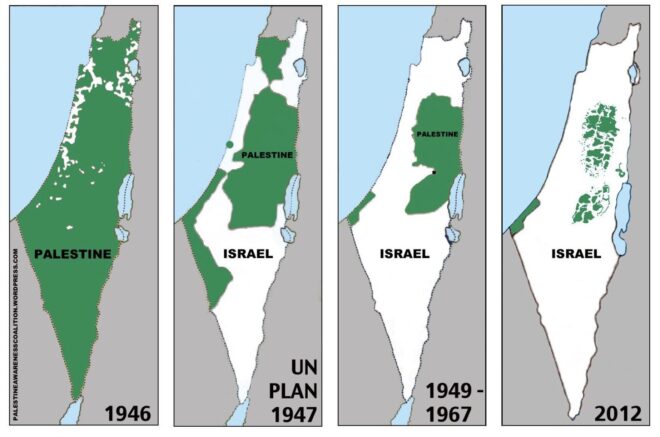
Abstract
This paper explores the historical context of Palestine during Ottoman rule and the subsequent transformations leading to the Nakba of 1948. It examines the Ottoman administrative structures, the rise of the Zionist movement, the conflicting promises made by Britain during World War I, and the policies of the British Mandate. The paper further analyses the implications of UN resolutions and Zionist settlement policies on the Palestinian population. By presenting a balanced view of the historical narrative, this study aims to provide a comprehensive understanding of the factors that contributed to the Nakba, emphasising the complexities and grievances of both Palestinians and Jews in the region.
Introduction
Palestine’s modern history is inextricably linked to the period of Ottoman rule (1516–1917), a time characterised by a diverse and fragmented social fabric. The Ottoman Empire’s governance left Palestinians without a unified political structure, a vulnerability that would have lasting repercussions as global political dynamics shifted in the early 20th century. The transition from Ottoman rule to British Mandate marked a significant turning point, particularly as conflicting promises made during World War I laid the groundwork for future tensions. The Nakba, or “catastrophe,” which refers to the mass displacement of Palestinians in 1948, serves as a critical event in understanding the historical grievances and ongoing conflict between Israelis and Palestinians.
Palestine Under Ottoman Rule
Administrative Structure and Demographics
The Ottoman Empire governed Palestine as a fragmented territory, employing administrative units such as the Mutasarrifate of Jerusalem, the Sanjak of Acre, and the Sanjak of Nablus. By 1917, Palestine’s population was approximately 700,000, predominantly Arab (90% Muslim and Christian) and a minority Jewish population (10%), consisting of both indigenous Jews and early Zionist settlers. The Ottomans did not officially recognise the term “Palestine,” and instead focused on local governance through religious and imperial affiliations, which fostered a sense of local identity among Palestinians without a cohesive political structure.
Cultural Significance of “Filastin”
The term Filastin, which means Palestine in Arabic, held cultural significance for the inhabitants of the region. It became increasingly prominent in the late Ottoman period, particularly in the context of media and cultural expression. The establishment of the newspaper Filastin in Jaffa in 1911, which reported on issues including Zionist land purchases, marked the emergence of a regional identity and awareness among the Arab population, signalling the beginnings of a national consciousness that would become more pronounced in the 20th century.
The Rise of the Zionist Movement
The late 19th century saw the emergence of the Zionist movement, spearheaded by figures like Theodor Herzl, who advocated for the establishment of a Jewish homeland in Palestine. The First Aliyah (1882–1903) brought approximately 25,000–35,000 Jewish settlers to Palestine, establishing agricultural communities and laying the groundwork for future tensions over land and resources. Despite Ottoman restrictions on immigration, many Zionist settlers found ways to purchase land, often at the expense of the local Arab population, thus sowing the seeds of conflict.
World War I and Britain’s Tripartite Promises
The Context of War
World War I drastically altered the political landscape of the Middle East. The Ottoman Empire’s alliance with the Central Powers prompted Britain to target the region for its strategic importance, particularly concerning the Suez Canal and oil resources. In this context, Britain made several contradictory promises regarding Palestine, which would later contribute to the Nakba.
1. McMahon-Hussein Correspondence (1915–1916)
The McMahon-Hussein Correspondence was a series of letters exchanged between British High Commissioner Sir Henry McMahon and Sharif Hussein bin Ali of Mecca. Britain promised support for an independent Arab state in exchange for an Arab revolt against the Ottomans. However, the vague definitions of territory led Hussein to believe that Palestine was included, while Britain later claimed it was excluded. This betrayal would fuel mistrust among Arab leaders.
2. Sykes-Picot Agreement (1916)
The secret Sykes-Picot Agreement, signed in May 1916, divided Ottoman territories between Britain and France. Palestine was designated for international administration, a decision that contradicted the promises made to the Arabs. The revelation of this agreement in 1917 shocked Arab leaders who had fought alongside the Allies, further deepening their sense of betrayal.
3. Balfour Declaration (1917)
The Balfour Declaration, issued on November 2, 1917, endorsed the establishment of a “national home for the Jewish people” in Palestine, with the caveat that the rights of existing non-Jewish communities be protected. This declaration was issued as British forces captured Jerusalem and aimed to secure Jewish support for the war effort. The declaration ignored the Arab majority and sparked protests among Palestinians, laying the groundwork for future conflict.
British Mandate Policies (1920–1948): Enabling Zionism and Suppressing Palestinian Resistance
The British Mandate for Palestine (1920–1948), established by the League of Nations, aimed to implement the Balfour Declaration and prepare the region for self-governance. However, the policies enacted during this period prioritised Zionist settlement while suppressing Palestinian resistance, ultimately paving the way for the Nakba.
1. Facilitation of Jewish Immigration and Settlement
Under the Mandate, British authorities facilitated Jewish immigration and settlement in Palestine. Policies included:
• Immigration Quotas: Britain permitted waves of Jewish immigration, leading to a significant increase in the Jewish population. By 1947, Jews comprised approximately 33% of the total population, with many arriving as Holocaust survivors.
• Land Acquisition: The Mandate supported land purchases by Jewish organisations, often resulting in the eviction of Palestinian tenants. By 1948, Jewish entities owned around 7% of the land, exacerbating tensions between communities.
• Institutional Support: The Jewish Agency received support for educational and military institutions, while Palestinian communities struggled for resources, leading to disparities in development and opportunity.
2. Suppression of Palestinian Resistance
Palestinian opposition to British policies was met with repression:
• Early Unrest: The 1921 Jaffa riots and the 1929 Hebron riots highlighted the growing tensions between Jewish settlers and the Arab population. British forces often intervened with excessive force, leading to casualties on both sides.
• Arab Revolt (1936–1939): Sparked by land sales and immigration, the Arab Revolt saw widespread protests and violence. British military responses included demolishing homes and executing leaders, significantly weakening Palestinian resistance.
• White Paper of 1939: This policy limited Jewish immigration and promised independence for Palestinians, but was rejected by both Zionists and Palestinians, as it failed to address their respective aspirations.
3. Failure to Mediate National Aspirations
The British Mandate failed to reconcile the competing national aspirations of Jews and Arabs. Key proposals, such as the Peel Commission’s partition plan, were rejected by Palestinians, who feared loss of land and self-determination. The lack of effective representation for Palestinians further fuelled discontent.
UN Resolutions: Shaping the Nakba and Its Aftermath
The United Nations played a pivotal role in shaping the trajectory of the Israeli-Palestinian conflict through various resolutions.
1. UN General Assembly Resolution 181 (1947)
Resolution 181 proposed partitioning Palestine into Jewish and Arab states, with Jerusalem under international administration. The plan allocated 56% of the land to the Jewish state despite Jews owning only 7% and comprising 33% of the population. Palestinians rejected the proposal, perceiving it as an unfair division that disregarded their rights to self-determination. The resolution’s acceptance by Zionists triggered immediate violence and displacement, leading to the 1948 war.
2. UN General Assembly Resolution 194 (1948)
Resolution 194 addressed the Palestinian refugee crisis and established the UN Conciliation Commission. It affirmed the right of refugees to return to their homes or receive compensation. However, Israel rejected this resolution, arguing that the return of refugees would undermine its Jewish majority. This resolution laid the groundwork for the Palestinian “right of return,” a core demand that remains unresolved.
3. Later UN Resolutions
Subsequent UN resolutions continued to address the conflict but often lacked enforcement mechanisms. For example, Security Council Resolution 242 called for Israel’s withdrawal from occupied territories, but did not lead to significant changes on the ground. The ongoing nature of the conflict reflects the inadequacies of international responses to the Palestinian plight.
Zionist Settlement Policies: Driving the Nakba
Zionist settlement policies, supported by the British Mandate and legitimised by UN resolutions, transformed Palestine significantly.
Pre-State Period (1880s–1948)
Zionist settlement efforts included:
• Immigration and Land Acquisition: Waves of Jewish immigration and land purchases led to the establishment of numerous settlements, often displacing Arab communities. The Jewish National Fund (JNF) played a crucial role in acquiring land for Jewish settlement.
• Settlement Types: Various forms of settlements, including kibbutzim and moshavim, were established to secure fertile lands and promote agricultural development.
During the Nakba (1947–1949)
The Nakba was marked by systematic expulsions and violence against Palestinian communities. The implementation of Plan Dalet facilitated the capture of territory and the displacement of Palestinians, with over 400 villages destroyed and significant loss of life.
Post-1948
Following the establishment of the State of Israel, policies continued to favour Jewish settlement, with land confiscated from Palestinian refugees. The expansion of settlements in the West Bank and Gaza has been viewed as a continuation of the Nakba, contributing to ongoing tensions and conflict.
The Nakba: A Human and Cultural Tragedy
The Nakba resulted in the displacement of approximately 750,000 Palestinians, many of whom sought refuge in neighbouring countries or within Palestine itself. The cultural and historical loss was profound, with many villages destroyed and erased from memory. The “right of return,” affirmed by UN Resolution 194, remains a contentious issue, as Israel continues to deny the return of refugees.
Ottoman Terminology and Palestinian Identity
The Ottoman era’s lack of a unified political entity called “Palestine” contributed to fragmentation among its inhabitants. However, the cultural significance of Filastin and the emergence of a national consciousness during the late Ottoman period laid the groundwork for a collective Palestinian identity that would solidify under the British Mandate.
Legacy and Ongoing Relevance
The legacy of the Nakba endures in the experiences of Palestinian refugees, the continued expansion of Israeli settlements, and the unresolved nature of the conflict. UN resolutions have highlighted international concern but have often lacked the enforcement necessary to bring about meaningful change. For Palestinians, the Nakba symbolises a profound loss and a demand for justice, while for Israelis, it presents challenges to narratives of statehood and security.
Conclusion
The Nakba was shaped by a confluence of factors, including Britain’s contradictory promises during World War I, the Ottoman Empire’s administrative structures, and the policies of the British Mandate. The rise of the Zionist movement and the subsequent establishment of a Jewish state culminated in the displacement of hundreds of thousands of Palestinians. UN resolutions, while acknowledging the rights of both parties, have failed to resolve the core issues at the heart of the conflict. The Nakba’s legacy—marked by the refugee crisis, the destruction of villages, and ongoing dispossession – demands recognition and understanding of the complex historical narratives that continue to shape the Israeli-Palestinian conflict today. Understanding this historical context is essential for addressing the injustices of the past and fostering a path toward a peaceful resolution in the future.



